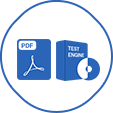Last Update 6 hours ago Total Questions : 59
The Dell Data Science Foundations content is now fully updated, with all current exam questions added 6 hours ago. Deciding to include D-DS-FN-23 practice exam questions in your study plan goes far beyond basic test preparation.
You'll find that our D-DS-FN-23 exam questions frequently feature detailed scenarios and practical problem-solving exercises that directly mirror industry challenges. Engaging with these D-DS-FN-23 sample sets allows you to effectively manage your time and pace yourself, giving you the ability to finish any Dell Data Science Foundations practice test comfortably within the allotted time.
What is the similarity between the matrix and array data structures in R?
In the data preparation phase of the data analytics lifecycle, what does the term “data conditioning” refer to?
What characterizes the Hadoop Distributed File System?
Consider this SQL statement: SELECT product, avg(prod_cost) FROM product_detail GROUP BY product. The GROUP BY clause implies what type of function?
Which phase of the data analytic lifecycle includes conducting project sponsor interviews and drafting a problem statement?
In K-means clustering, what is a graph of the WSS versus the value of K used to help determine?
In a user-defined aggregate function, what is FFUNC?

